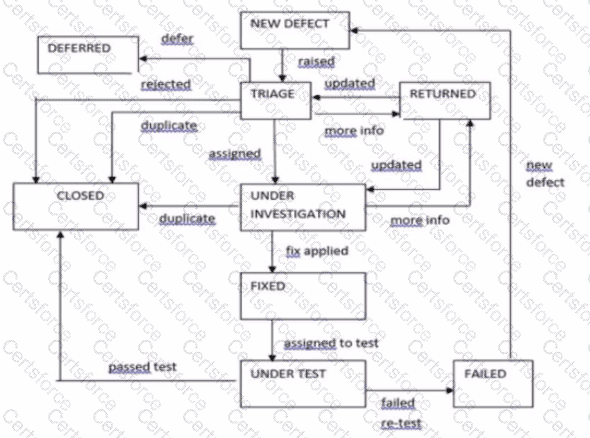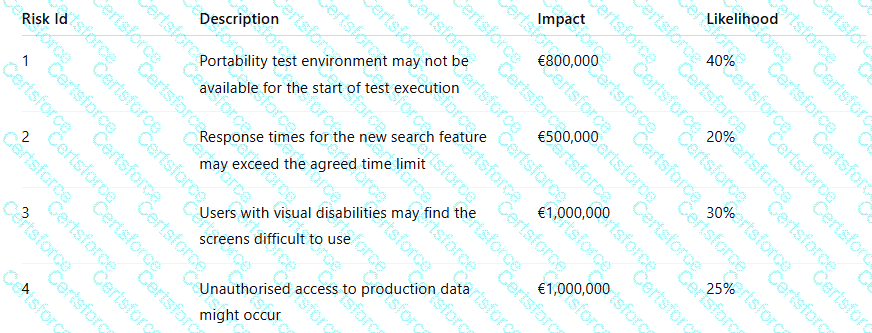Consider the following metrics:
a Percentage of all product risks identified during initial risk analysis
b. Average time taken by developers to fix defects for each severity level
c. Statement coverage achieved by the component test suite
d. Breakdown of defects detected by test level
How many of the five primary dimensions for test progress monitoring have been addressed by these metrics?
SELECT ONE OPTION
Which of the following is MOST likely to influence the choice of test levels for a project?
You are Test Manager on a new project and have estimated the test effort to be 500 days, assuming that you will find no more than 50 defects and 5 test iterations being required. The project manager has said the estimate is too high. Which of the following options could enable you to reduce this estimate?
SELECT ONE OPTION
Your Project Manager has challenged you to come up with a process improvement strategy using the IDEAL model.
Which step within the process defines the success criteria? [2]
Your test team has created a custom automation tool that will be used for an upcoming release. Now that the tool has been coded, what
should be the next step? [1]
You have recently implemented a new defect management process which now includes a defect triage committee whose job is to review all new defects. The process is shown in the following diagram:

b. The total number of defects rejected as not a problem following investigation by the product author
c. The number of defects returned to the defect author, expressed as a percentage of all defects raised
d. The total number of defects that failed re-test more than once
e. The total number of defects closed by the defect triage committee
SELECT ONE OPTION
You are writing the project test plan and are analysing the following risks in the project risk register:

Which would be the MOST appropriate test activities to mitigate the product risks?
Most managers in your company consider the efforts of your test team valuable, while others seecomprehensive testing as an unnecessary cost overhead to the SDLC.
What action could the Test Manager take to quantify the value of testing to the organization? [3]
An old stock control system is being decommissioned and replaced with a new system that has been running successfully in the live environment for the last few months. The stakeholders would like to -
• retain historical information held in the database to comply with their data retention policy (which requires order information to be retained for 7 years)
• query the historical information by running pre-written SQL queries.
• all commands must be invoked by keyboard as one of the end users is unable to use a mouse
The pre-written SQL queries will be designed, developed and tested by the developers who are decommissioning the system and writing the data migration routine.
As the system to be decommissioned is integrated to other systems that will remain operational, the stakeholders have requested that testing incorporates all systems that are part of the stock control suite.
The stakeholders and project manager have identified the following risks, in priority order -
• 1st - Data has not been successfully migrated to an archived data store, resulting in the inability to query past stock levels and re-order details.
• 2nd - Historical data for the last 7 years is unavailable, resulting in the failure to meet the data retention policy.
• 3rd - Failure of existing systems within the stock control suite, adversely affecting the operational running of the business
The risks are to form the basis of the test objectives. Which three of the following test activities, work products and/or resources achieves the test objectives?
a. Use of the live database to test the data migration does not corrupt or lose data
b. A test plan detailing the test approach for ST. SIT & OT test levels
c. Accessibility testing of the pre-defined SQL queries
d. Security and Penetration testing of the archived database
e Performance testing of the data migration exercise to ensure it completes in the time specified by the stakeholders
f. Functional testing of the pre-defined SQL queries
g. Regression testing of the end to end process for maintaining specified stock levels.
You are writing a system test level plan and are defining the test activities that must take place during test implementation. There is an established project risk register in place, with product risks addressing all new features to be developed. Three time-boxed cycles of system test execution are planned, and all the new features will be delivered in the first cycle.
The project test strategy states that the stakeholders require an overall view of the product quality for these features. This should be achieved by planning to test each product risk, to some degree, during the first cycle of test execution.
Which risk-based mitigation approach should be adopted during test implementation, to BEST meet the stakeholders' requirement?